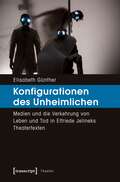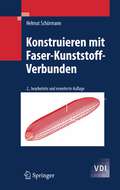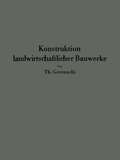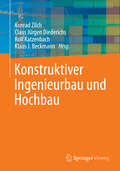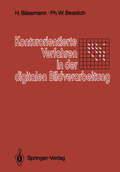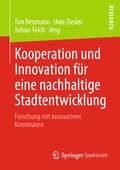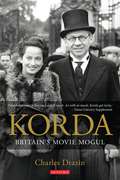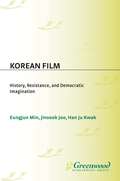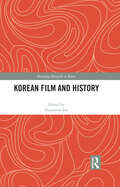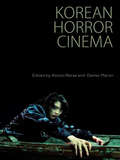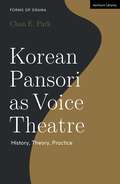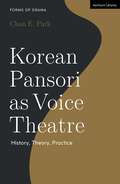- Table View
- List View
Kompendium digitale Fotografie: Von der Theorie zur erfolgreichen Fotopraxis (X.media.press)
by Tilo GockelViele Anwender moderner digitaler Spiegelreflex- oder Kompaktkameras sind mit den erreichten Ergebnissen unzufrieden. Das Buch hilft dabei, die gewünschten Effekte zu erzielen. Hierfür werden ausgehend von den notwendigen theoretischen Grundlagen Ratschläge für praktische immer wiederkehrende Aufgaben und Themen wie Langzeitbelichtung oder Weißabgleich gegeben. Anhand vieler Beispiele zeigt der Autor konkret, welche Ergebnisse und Verbesserungen mit digitaler Fotografie erreicht werden können. Das Buch regt zum Experimentieren an und bietet in Anhängen detaillierte technische Grundlagen und ermöglicht so eine solide Praxisorientierung vom Motiv bis zum Bild.
Komplexität auf der Bühne: Zur Dramaturgie der Geschichtenverflechtung in zeitgenössischen Theatertexten (Theater #164)
by Ute ScharfenbergWie kann das Theater unsere heutigen opaken Wirklichkeitsverhältnisse vermitteln? Und wie können Bühnenaktionen Vorstellungen von Zusammenhang und Sinn mobilisieren? Ute Scharfenberg analysiert erstmals zeitgenössische Theatertexte, die mit außerordentlich hohen Komplexitätsgraden der Darstellung experimentieren. Die komplizierten »Verflechtungsfabeln« bringen Figuren und Ereignisse in oft überraschende Korrespondenzen und fordern ein kritisch-assoziatives Imaginieren und deutendes Interpretieren heraus. Ihre neuartigen Techniken verleihen der Darstellungs- wie auch der Zuschaukunst eine eminente Produktivität.
Konfigurationen des Unheimlichen: Medien und die Verkehrung von Leben und Tod in Elfriede Jelineks Theatertexten (Theater #93)
by Elisabeth GüntherDer Begriff des »Unheimlichen« birgt einiges Potenzial, um aktuelle Diskurse über die fortschreitende Technisierung unserer Gesellschaft auf den Punkt zu bringen. Vor diesem Hintergrund untersucht Elisabeth Günther eine Auswahl an Theatertexten von Elfriede Jelinek und fokussiert dabei insbesondere die beiden für deren Werk zentralen Topoi der Medien und des Untoten. Hierzu zieht sie neben den traditionellen psychoanalytischen Bezügen zum Unheimlichen-Begriff verschiedene Theoriediskurse zu Fragen der Wirklichkeitsherstellung heran, wie sie u.a. im Kontext der Denkansätze von Jacques Derrida und Jean Baudrillard geführt werden. Jelineks virtuoses Spiel mit der Verkehrung von Belebtheitsverhältnissen entpuppt sich dabei als differenzierte Kritik an der gegenwärtigen Mediengesellschaft.
Konservierung und Pflege von Kulturgut: Ein Leitfaden für die Praxis (Schriften zum Kultur- und Museumsmanagement)
by Sabine MaurischatKunstschätze und Kulturgut benötigen besondere Pflege, um sie möglichst lange bewahren zu können. Der Ansatz der »Präventiven Konservierung« gibt dazu alle wichtigen Informationen an die Hand. Doch wie setzt man die Theorie in der Praxis um? Kurz und knapp stellt Sabine Maurischat die unterschiedlichen Werkstoffe der Konservierung vor und vermittelt einen Eindruck zur Materialität von Kulturgütern. In Schritt-für-Schritt-Anleitungen - praxisnah und verständlich - erklärt sie, wie Objekte gehandhabt, inventarisiert, verpackt und für Ausstellungen vorbereitet werden. Dabei geht es immer um einen Kompromiss zwischen den zwei Grundpfeilern der musealen Arbeit: Bewahren und Vermitteln.
Konstantin Stanislavsky (Routledge Performance Practitioners)
by Bella MerlinAs one of the most well-known names in theatre history, Konstantin Stanislavsky’s teachings on actor training have endured throughout the decades, influencing scholars and practitioners even in the present day. This second edition of Konstantin Stanislavsky combines: an overview of Stanislavsky’s life and work, including recent discoveries an assessment of his widely read text, An Actor Prepares (1936) with comparisons to Benedetti’s 2008 translation, An Actor’s Work detailed commentary of the key 1898 production of The Seagull an indispensable set of practical exercises for actors, teachers and directors. As a first step towards critical understanding, and as an initial ex- ploration before going on to further, primary research, Routledge Performance Practitioners are unbeatable value for today’s student.
Konstantin Stanislavsky (Routledge Performance Practitioners)
by Bella MerlinAs one of the most well-known names in theatre history, Konstantin Stanislavsky’s teachings on actor training have endured throughout the decades, influencing scholars and practitioners even in the present day. This second edition of Konstantin Stanislavsky combines: an overview of Stanislavsky’s life and work, including recent discoveries an assessment of his widely read text, An Actor Prepares (1936) with comparisons to Benedetti’s 2008 translation, An Actor’s Work detailed commentary of the key 1898 production of The Seagull an indispensable set of practical exercises for actors, teachers and directors. As a first step towards critical understanding, and as an initial ex- ploration before going on to further, primary research, Routledge Performance Practitioners are unbeatable value for today’s student.
Konstruieren mit Faser-Kunststoff-Verbunden (VDI-Buch)
by Helmut SchürmannDas Buch führt umfassend in das Fachgebiet ein. Es behandelt Werkstoffkunde, Elastostatik, Festigkeitslehre, Entwurfsmethoden und Verbindungstechniken. Im Vordergrund stehen die Verfahren zur Dimensionierung, die wichtigsten Konstruktionsprinzipien und die Berechnung hoch belastbarer Faserverbundstrukturen. Der Autor leitet wichtige Beziehungen her, die man eigenen Untersuchungen zugrunde legen kann. Die 2. Auflage bietet detaillierte Abbildungen und Übungen und ist ergänzt um Regeln zur Gestaltung von FKV-Strukturen und ein Kapitel zu besonderen konstruktiven Lösungen. Plus: aktuelle Festigkeitswerte, neue Hinweise auf optimale Laminate.
Konstruktion landwirtschaftlicher Bauwerke
by Th. GesteschiDieser Buchtitel ist Teil des Digitalisierungsprojekts Springer Book Archives mit Publikationen, die seit den Anfängen des Verlags von 1842 erschienen sind. Der Verlag stellt mit diesem Archiv Quellen für die historische wie auch die disziplingeschichtliche Forschung zur Verfügung, die jeweils im historischen Kontext betrachtet werden müssen. Dieser Titel erschien in der Zeit vor 1945 und wird daher in seiner zeittypischen politisch-ideologischen Ausrichtung vom Verlag nicht beworben.
Konstruktiver Ingenieurbau und Hochbau
by Konrad Zilch Claus Jürgen Diederichs Rolf Katzenbach Klaus J. BeckmannStudierende des Bauingenieurwesens werden durch kompaktes Wissen auf ihre komplexen Aufgaben vorbereitet und auf Vertiefungsmöglichkeiten hingewiesen. Praktiker können ihren Wissensstand insbesondere auch auf solchen Gebieten aktualisieren, die nicht zu ihrem Alltagsgeschäft gehören.
Konsum zeigen: Die neue Öffentlichkeit von Konsumprodukten auf Flickr, Instagram und Tumblr (Konsumästhetik #3)
by Simon BielingUnternehmen und Werbeagenturen bestimmen seit gut zehn Jahren nicht mehr allein, wie Konsumprodukte öffentlich in Bildern dargestellt werden. Wozu man sie verwenden und was man sich von ihnen erwarten kann, darüber tauschen sich Konsumentinnen und Konsumenten heute auch eigenständig auf Bildplattformen wie Instagram, Tumblr und Flickr miteinander aus. Mithilfe einer eigens entwickelten Methode zeigt Simon Bieling erstmals umfassend, wie sich unser Verhältnis zu Marken und Produkten der Konsumwelt verändert hat - und wie die Bilderwelten der Social Media uns differenzierte Einsichten in die Alltagskultur der Gegenwart verschaffen können.
Kontingenz, Künstlichkeit und Travestie: Zur Neubeschreibung von Themenarchitekturen (Architekturen #62)
by Christian RablDie architekturtheoretische Aufarbeitung des weltweit metastasierenden Phänomens der Themenarchitektur ist durch Aggression und Unverständnis charakterisiert. Der Architekturdiskurs disqualifiziert die plakative, zitathafte Künstlichkeit thematischer Simulationsästhetiken als manipulative »Hyperrealität«. Christian Rabl begreift demgegenüber die rezeptiven Kontingenzeindrücke der sekundaristischen, artifiziellen Themenarchitekturen als (unbeabsichtigte) parodistische »Travestien« und als potenziell befreiend, sofern sie essentialistisch sedimentierte Ordnungsvorstellungen delegitimieren. In seiner anti-essentialistischen Neubeschreibung analysiert er dazu u.a. die simulatorischen Stadtästhetiken von Las Vegas, Orlando und Dubai.
Konturorientierte Verfahren in der digitalen Bildverarbeitung
by Henning Bässmann Philipp W. BesslichKooperation und Innovation für eine nachhaltige Stadtentwicklung: Forschung mit innovativen Kommunen
Die Autoren stellen die Ergebnisse des Projekts IER-SEK zusammenfassend vor. IER-SEK ist das Instrument zur Entscheidungsunterstützung für Großvermieter zur Realisierung von Stadtentwicklungskonzepten und wurde im Rahmen der BMBF-Initiative Kommunen innovativ gefördert. Das Buch gibt aber auch einen Ausblick auf weitere Themen, welche die nachhaltige Stadtentwicklung beeinflussen, dazu gehören Stadtentwicklung und Mensch sowie Technologie und Energie.Die Herausgeber:M.Sc. Tim Neumann ist wissenschaftlicher Mitarbeiter an der Westsächsischen Hochschule Zwickau. Dipl.-Ing. Uwe Ziesler arbeitet in der Stabsstelle Stadtentwicklung der Stadt Zwickau. Prof. Dr. rer. pol. habil. Dr.-Ing. Tobias Teich ist Professor für Vernetzte Systeme in der Betriebswirtschaft an der Westsächsischen Hochschule Zwickau.
Köpriyet: Republican Heritage Bridges of Turkey
by Hulya Sonmez SchaapKöpriyet: Republican Heritage Bridges of Turkey deals with bridges and the construction industry of Turkey during the foundation of the Republic between 1923 and 1940. This book provides a brief summary of the bridge history of the country, but the main focus is on the Early Republic Era. During this period, the bridge-building technique was reborn in a country undergoing a radical transformation. Turkey changed its ruling, secularized and changed its alphabet. In addition to detailed descriptions of bridges built during this period and of leading innovative engineers, this book provides a first documented overview of heritage bridges in Turkey, focusing on applied techniques known worldwide. Many bridges are documented for the first time in this book, and most of them are heritage bridges and provide significant value in terms of bridge-building technology and application of worldwide techniques. In the waning days of the Ottoman Empire, engineering projects in Turkey were often carried out through "privileges" by foreign companies. The technical personnel were also financed with foreign resources. With the new Republic, Turkey experienced a renaissance in many areas, including technology. This transition from technology import to development and use of local resources is described in detail. Köpriyet: Republican Heritage Bridges of Turkey provides a wealth of information and documentation on bridges in Turkey from an important era, and aims at those interested in bridge structures and structural engineering history.
Köpriyet: Republican Heritage Bridges of Turkey
by Hulya Sonmez SchaapKöpriyet: Republican Heritage Bridges of Turkey deals with bridges and the construction industry of Turkey during the foundation of the Republic between 1923 and 1940. This book provides a brief summary of the bridge history of the country, but the main focus is on the Early Republic Era. During this period, the bridge-building technique was reborn in a country undergoing a radical transformation. Turkey changed its ruling, secularized and changed its alphabet. In addition to detailed descriptions of bridges built during this period and of leading innovative engineers, this book provides a first documented overview of heritage bridges in Turkey, focusing on applied techniques known worldwide. Many bridges are documented for the first time in this book, and most of them are heritage bridges and provide significant value in terms of bridge-building technology and application of worldwide techniques. In the waning days of the Ottoman Empire, engineering projects in Turkey were often carried out through "privileges" by foreign companies. The technical personnel were also financed with foreign resources. With the new Republic, Turkey experienced a renaissance in many areas, including technology. This transition from technology import to development and use of local resources is described in detail. Köpriyet: Republican Heritage Bridges of Turkey provides a wealth of information and documentation on bridges in Turkey from an important era, and aims at those interested in bridge structures and structural engineering history.
Korda: Britain's Movie Mogul
by Charles DrazinThe producer behind such celebrated films as The Four Feathers and The Third Man is one of the most colourful and important figures in the history of the British cinema. This gripping biography tells how with extraordinary ambition, enterprise and showmanship, Alexander Korda established in Britain a film industry that rivalled Hollywood, built Europe's biggest studio, and created world-class stars, including Charles Laughton and Vivien Leigh.The biography traces Korda's path from his rural childhood in a remote part of Hungary to a British knighthood. Korda's legacy, it argues, was a film industry that dared to dream on the largest possible scale. But he also exemplified the pattern of boom and bust that dogged the British cinema ever since he first came into the limelight in 1933 with the international success of The Private Life of Henry VIII. To understand his often turbulent career is to gain a profound insight into the nature of the British cinema both then and now.'In this thorough and jaunty biography, Drazin gives us a masterly portrait.' - Sunday Times'An engrossing exegesis of film-making in inter- war Britain and a rounded portrait of what we'd now call an economic migrant who lived profligately, left others poorer and occasionally and enduringly enriched the screen.' - Evening Standard'Wry, ruthless and expertly researched.' - Financial Times
A Korean Approach to Actor Training
by Jeungsook YooA Korean Approach to Actor Training develops a vital, intercultural method of performer training, introducing Korean and more broadly East Asian discourses into contemporary training and acting practice. This volume examines the psychophysical nature of a performer’s creative process, applying Dahnhak, a form of Korean meditation, and its central principle of ki-energy, to the processes and dramaturgies of acting. A practitioner as well as a scholar, Jeungsook Yoo draws upon her own experiences of training and performing, addressing productions including Bald Soprano (2004), Water Station (2004) and Playing ‘The Maids’ (2013–2015). A significant contribution to contemporary acting theory, A Korean Approach to Actor Training provides a fresh outlook on performer training which will be invaluable to scholars and practitioners alike.
A Korean Approach to Actor Training
by Jeungsook YooA Korean Approach to Actor Training develops a vital, intercultural method of performer training, introducing Korean and more broadly East Asian discourses into contemporary training and acting practice. This volume examines the psychophysical nature of a performer’s creative process, applying Dahnhak, a form of Korean meditation, and its central principle of ki-energy, to the processes and dramaturgies of acting. A practitioner as well as a scholar, Jeungsook Yoo draws upon her own experiences of training and performing, addressing productions including Bald Soprano (2004), Water Station (2004) and Playing ‘The Maids’ (2013–2015). A significant contribution to contemporary acting theory, A Korean Approach to Actor Training provides a fresh outlook on performer training which will be invaluable to scholars and practitioners alike.
Korean Film: History, Resistance, and Democratic Imagination (Non-ser.)
by Eungjun Min Jinsook Joo Han Ju KwakDespite its rise in the global market, recent political progress, and a surging interest worldwide, Korean films are relatively unknown and rarely studied. This new work begins by investigating the history, industry structure, and trends of filmmaking in Korea, going on to examine how Hollywood films have affected both Korean mainstream and nonmainstream film industries in terms of both means of production and narrative. Moreover, the authors analyze the ways in which Korean films of recent years have represented the modernization process in Korea itself, as well as the ideological implications that arise from the cinematic constructions of Korean imagination.More than a mere chronological account of Korean cinematic history, ^IKorean Film^R attempts to consider the films as a popular cultural form that have a life beyond their theatrical runs: stars, genres, and key movies become part of any culture's identity, and in their narratives and meanings can be located evidence of the ways in which a culture makes sense of itself. Korea has never before been given such an extensive treatment of this central idea, and here for the first time, the nation's culture and cinema are merged into one discussion that both reflects and shapes our understanding of it.
Korean Film and History (Routledge Research on Korea)
by Hyunseon LeeCinema has become a battleground upon which history is made – a major mass medium of the twentieth century dealing with history. The re-enactments of historical events in film straddle reality and fantasy, documentary and fiction, representation and performance, entertainment and education. This interdisciplinary book examines the relationship between film and history and the links between historical research and filmic (re-)presentations of history with special reference to South Korean cinema. As with all national film industries, Korean cinema functions as a medium of inventing national history, identity, and also establishing their legitimacy – both in forgetting the past and remembering history. Korean films also play a part in forging cultural collective memory. Korea as a colonized and divided nation clearly adopted different approaches to the filmic depiction of history compared to colonial powers such as Western or Japanese cinema. The Colonial Period (1910-45) and Korean War (1950-53) draw particular attention as they have been major topics shaping the narrative of nation in North and South Korean films. Exploring the changing modes, impacts and functions of screen images dealing with history in Korean cinema, this book will be of huge interest to students and scholars of Korean history, film, media and cultural studies.
Korean Film and History (Routledge Research on Korea)
Cinema has become a battleground upon which history is made – a major mass medium of the twentieth century dealing with history. The re-enactments of historical events in film straddle reality and fantasy, documentary and fiction, representation and performance, entertainment and education. This interdisciplinary book examines the relationship between film and history and the links between historical research and filmic (re-)presentations of history with special reference to South Korean cinema. As with all national film industries, Korean cinema functions as a medium of inventing national history, identity, and also establishing their legitimacy – both in forgetting the past and remembering history. Korean films also play a part in forging cultural collective memory. Korea as a colonized and divided nation clearly adopted different approaches to the filmic depiction of history compared to colonial powers such as Western or Japanese cinema. The Colonial Period (1910-45) and Korean War (1950-53) draw particular attention as they have been major topics shaping the narrative of nation in North and South Korean films. Exploring the changing modes, impacts and functions of screen images dealing with history in Korean cinema, this book will be of huge interest to students and scholars of Korean history, film, media and cultural studies.
Korean Horror Cinema
by Alison Peirse Daniel MartinAs the first detailed English-language book on the subject, Korean Horror Cinema introduces the cultural specificity of the genre to an international audience, from the iconic monsters of gothic horror, such as the wonhon (vengeful female ghost) and the gumiho (shapeshifting fox), to the avenging killers of Oldboy and Death Bell. Beginning in the 1960s with The Housemaid, it traces a path through the history of Korean horror, offering new interpretations of classic films, demarcating the shifting patterns of production and consumption across the decades, and introducing readers to films rarely seen and discussed outside of Korea. It explores the importance of folklore and myth on horror film narratives, the impact of political and social change upon the genre, and accounts for the transnational triumph of some of Korea’s contemporary horror films. While covering some of the most successful recent films such as Thirst, A Tale of Two Sisters, and Phone, the collection also explores the obscure, the arcane and the little-known outside Korea, including detailed analyses of The Devil’s Stairway, Woman’s Wail and The Fox With Nine Tails. Its exploration and definition of the canon makes it an engaging and essential read for students and scholars in horror film studies and Korean Studies alike.
Korean Pansori as Voice Theatre: History, Theory, Practice (Forms of Drama)
by Chan E. ParkThis book introduces readers to the historical, performative, and cultural context of pansori, a traditional Korean oral story-singing art. Written by a scholar-practitioner of the form, this study is structured in three parts and begins by introducing readers to the technical, aesthetic, and theoretical components of pansori, as well as the synthesis of vocal and percussive elements that stage the narrative. It moves on to reflect on the historical contexts of pansori, alongside Korea's transformation from Joseon monarchy to modern statehood. It argues that with colonial annexation came modernist influences that Korean dramatists and audiences used to create new genres of performance, using the common thread of pansori. The book's third part explores the interplay of preservation and innovation, beginning in the post-war period and continuing with developments in the 20th and 21st centuries that coincide with Korea's imprint on cultural globalization. Along with Korea's growth as a world economic center, a growing enthusiasm for Korean culture around the world has increased the transmission and visibility of pansori. This study argues that tradition and innovation are not as divergent as they are sometimes imagined to be and that tradition is the force that enables innovation. Drawing on Chan E. Park's ethnographic work and performance practice, this book interweaves expert knowledge of both the textual and performative aspects of pansori, rendering legible this dramatic tradition.
Korean Pansori as Voice Theatre: History, Theory, Practice (Forms of Drama)
by Chan E. ParkThis book introduces readers to the historical, performative, and cultural context of pansori, a traditional Korean oral story-singing art. Written by a scholar-practitioner of the form, this study is structured in three parts and begins by introducing readers to the technical, aesthetic, and theoretical components of pansori, as well as the synthesis of vocal and percussive elements that stage the narrative. It moves on to reflect on the historical contexts of pansori, alongside Korea's transformation from Joseon monarchy to modern statehood. It argues that with colonial annexation came modernist influences that Korean dramatists and audiences used to create new genres of performance, using the common thread of pansori. The book's third part explores the interplay of preservation and innovation, beginning in the post-war period and continuing with developments in the 20th and 21st centuries that coincide with Korea's imprint on cultural globalization. Along with Korea's growth as a world economic center, a growing enthusiasm for Korean culture around the world has increased the transmission and visibility of pansori. This study argues that tradition and innovation are not as divergent as they are sometimes imagined to be and that tradition is the force that enables innovation. Drawing on Chan E. Park's ethnographic work and performance practice, this book interweaves expert knowledge of both the textual and performative aspects of pansori, rendering legible this dramatic tradition.
The Korean War and Postmemory Generation: Contemporary Korean Arts and Films (Routledge Advances in Korean Studies)
by Dong-Yeon KohThis pioneering volume navigates cultural memory of the Korean War through the lens of contemporary arts and film in South Korea for the last two decades. Cultural memory of the Korean War has been a subject of persistent controversy in the forging of South Korean postwar national and ideological identity. Applying the theoretical notion of “postmemory,” this book examines the increasingly diversified attitudes toward memories of the Korean War and Cold War from the late 1990s and onward, particularly in the demise of military dictatorships. Chapters consider efforts from younger generation artists and filmmakers to develop new ways of representing traumatic memories by refusing to confine themselves to the tragic experiences of survivors and victims. Extensively illustrated, this is one of the first volumes in English to provide an in-depth analysis of work oriented around such themes from 12 renowned and provocative South Korean artists and filmmakers. This includes documentary photographs, participatory public arts, independent women’s documentary films, and media installations. The Korean War and Postmemory Generation will appeal to students and scholars of film studies, contemporary art, and Korean history.


